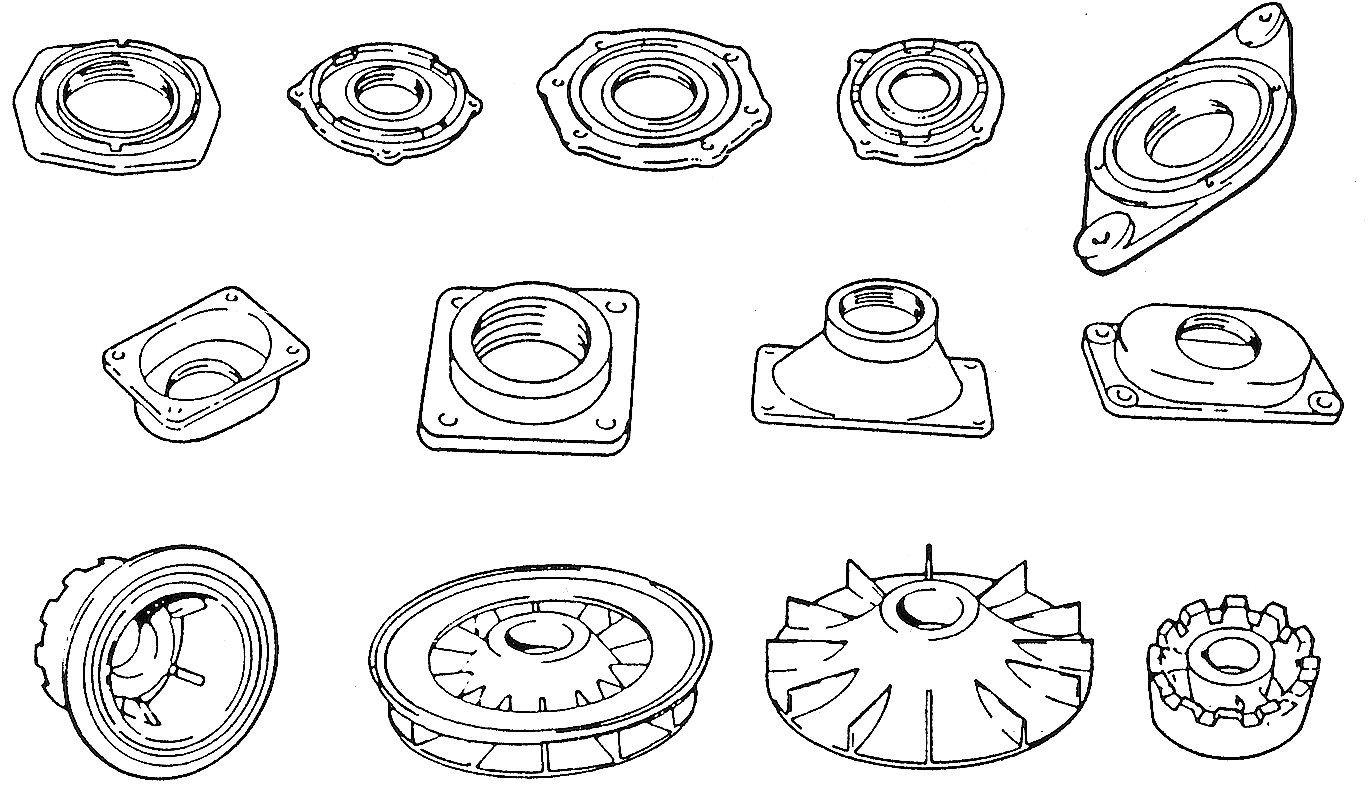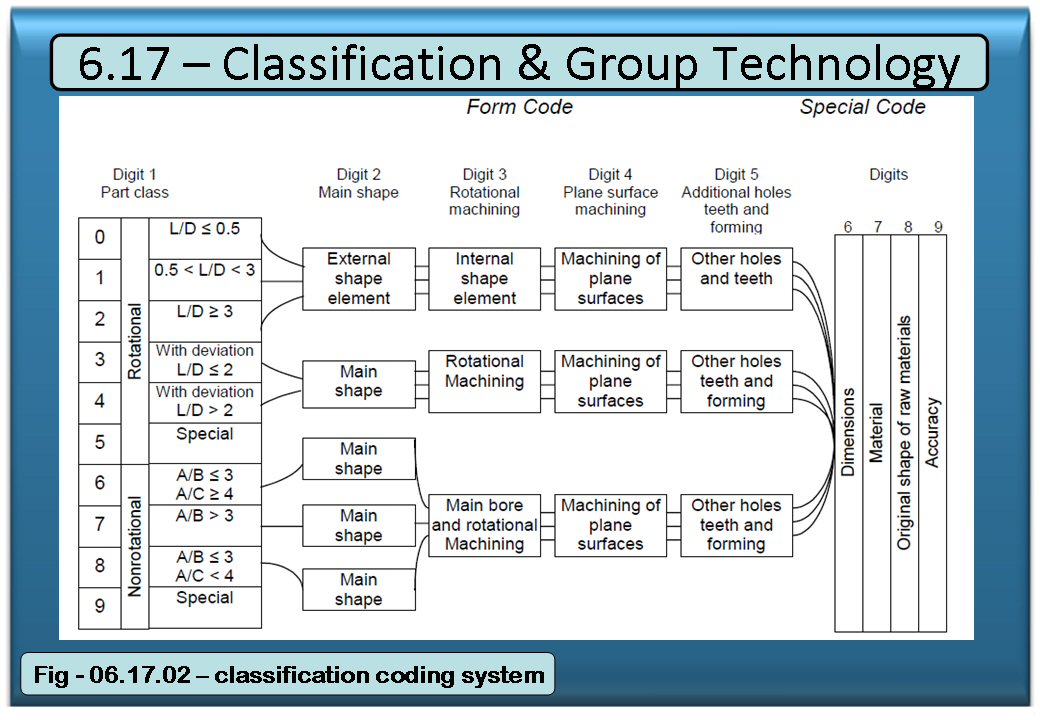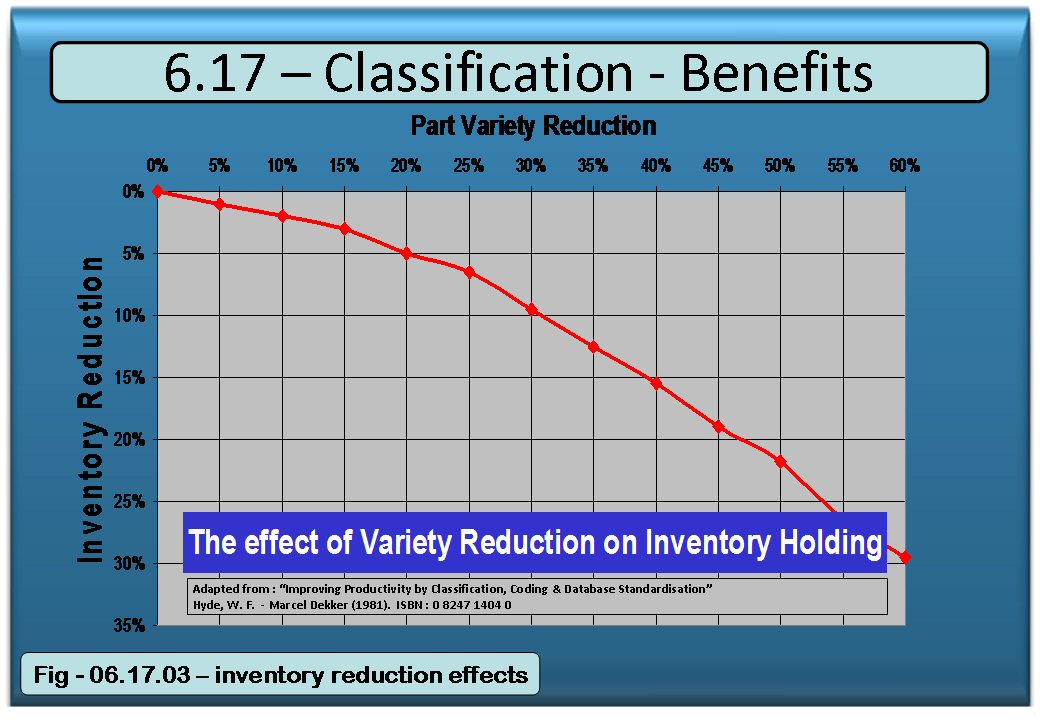6.17 - Part Classification and Group Technology
Manufacturing managers know that information or data that cannot be accessed is virtually useless. A company’s intellectual property is contained in the products and parts it has created to solve particular design problems. According to one source, “Up to 80% of the work done in an engineering department is identical or very similar to work done previously” (from research by Arthur D Little). Unfortunately this investment is not always managed effectively. One of the most satisfying tasks to reduce design and manufacturing costs is to implement a part cataloguing and retrieval system enabling previous design work and parts to be re-used.
Classification Systems Requirements
It is important to realise that the classification system has to satisfy at least two major user requirements:-
- Designer Engineers – need to find things by their functional attributes
- Manufacturing Engineers – need to find the processing routes used to make those things
To illustrate the issues see the diagram below:-
Flat Flanges |

|
Deep Flanges |
Impellers |
The design engineer will search for flanges or impellers and the manufacturing engineer will pull all those items into a single class because they have similar manufacturing routes and can be made in the same manufacturing cell.
Classification – Definitions
Dictionary Definition: A system to arrange things in order.
Applied to industry, “A classification system must be able to organize data relating to the relevant component element(s) of a business in a logical and systematic hierarchy, whereby like things are brought together by virtue of their similarities, and then separated by their essential differences.” – Joseph Gombinski – Brisch Birn & Co.
To illustrate consider this simple functional classification using MRP or PLM item master records:-
Part Number |
Primary Description (or Main Noun) |
Secondary Description (attributes) |
1234-01 |
Bolt |
Hex M 5 x 25mm |
1234-02 |
Bolt |
Hex M 5 x 30mm |
1236-01 |
Screw |
Hex M 5 x 20mm |
1237-03 |
Nut |
Hex M 5 |
16547 |
Gear Pump |
40 Liters / min @ 10 bar |
16438 |
Gear Pump |
100 Liters / min @ 5 bar |
7465-02 |
Bar |
Square 5mm x 5mm |
This approach, in the absence of a formal classification system, is a good place to start. Selecting and sorting on either description enables the fairly quick location of previously designed parts. Displayed with a thumbnail image of the part it can be powerful in its own right. It also lays the groundwork for formal classification systems implementation. The primary description would be used on external documents only (e.g. maintenance and service manuals so as NOT to give away any IP) whereas the secondary would be used internally for search, retrieval and recognition purposes. Some of that information can be used to populate a manufacturing process coding system or functional coding system.
Structure, Order and Similarity Management Brings Benefits
Below are benefits reported by companies using group technology (GT)
- 52% Report reduction in new part design
- 10% Report reduction in # of new drawings thru standardization
- 30% Report reduction in new drawings
- 60% Report reduction in Industrial (or Manufacturing) Engineers time
- 20% Report reduction in floor space
- 45% Report reduced scrap
- 80% Report reduced production and quality costs
- 69% Report reduced set-up time (cost)
- 70% Report reduced throughput time (even more report better predictability of delivery)
- 82% Report reduced numbers of overdue orders
- 42% Report reduced raw-materials inventory
- 62% Report reduced Work In Progress
- 60% Report reduced finished goods inventory
- 33% Report increased employee output/time unit (productivity improvement)
Uncontrolled New Design Costs Time and Money
When a new part number is created it sets in motion a chain of events and work activity that costs huge amounts of cash. The chart below illustrates:-
Life-cycle Step |
People |
Documents and Data |
1 – Concept Research |
Design Engineers |
Layouts & Schemes |
2 – Physical Design |
Detail Designers |
3D CAD, FE, FEA, & 2D Data |
3 – Prototype Build |
Development Engineers |
Test Reports / test data |
4 – Part Sign-off |
Various |
Release Documents |
5 – Process & Routing |
Manufacturing Engineers |
Process Sheets |
6 – Tooling Design |
Tool Designers |
Tool & Gauge Drawings |
7 – Make Tools & Jigs |
Tool Makers |
Tool Stores records |
8 – Work Study |
Industrial Engineers |
Time Standards |
9 – Production Control |
Production Controllers |
Stores Space Allocation |
10 – Cost Accounting |
Accountants |
Materials & Prod Cost Data |
11 – Data Processing |
Data Entry Clerks |
Various Computer Records |
Adapted from: “Improving Productivity by Part Classification & Coding” – W F Hyde |
About 20% of the cost is in the first 4 steps. In the 1990’s the average cost for the full cycle was calculated to be about £10,000. Applying a simple inflation factor would give a current cost.
Alternatively, an Activity Based Costing approach based on a Flow Chart model of the above steps should also produce new part introduction cost for a specific company.
See guide 8.03 for more information.
A rough-cut number could be calculated by taking the annual cost for R&D and dividing it by the number of new parts issued each year.
Considerations when Designing a Classification Structure
- External parts and raw materials management
- Use of standard classification systems (e.g. DIN 4000)
- Functional characteristics
- Equivalent supplier part numbers cross-referenced to company numbers
- Supplier & vendor management
- In-house parts design management
- Form/shape classification + functional
- In-house scheme—company/industry specific
- Group technology for process and routing
- Cell design and factory layout
- Sales or customer product features management
- Features & options management (input to Product Configurators)
- In-house scheme—company/industry specific
- Controlled product variety
- Design (or configuration) module management
A Shape Based Classification System used to Estimate Costs
Click here for more information on a shape based classification system :-
Shape help for Cost Estimator Tool
One of the key factors to remember when designing a coding and retrieval system is to separate the coding or class numbers from the part identification numbers. Part identification numbers need to be unique. Coding numbers could be the same for similar parts depending on the depth of the coding system. Sadly we still see “experts” advocating meaningful part numbering schemes.
The second purpose of classification is to enable manufacturing engineers to design factories and processes to handle the component designs. They need a compatible way of classifying parts and the machines or processes on which they are manufactured be made. The Opitz classification and coding system uses this approach. See below:-

Search and retrieval depends on knowing the “Codes” and is usually not intuitive enough for the design engineer.
Some work has been done on retrieval by classification of the 2D or 3D shape of items in a CAD database.
Other research work has been done on expanding the coding systems to cover “Functional Codes” by extending the numeric coding systems to include functional characteristics derived from the descriptive names given to parts.
Benefits of Part Classification and Coding

- Defines standard parts and libraries
- Supports access to information in user terminology
- Improves ability to offer product variety
- Provides better reuse of designs and parts
- Reduces design time
- Reduces inventory and scrap/re-work throughout the supply chain for:
- Raw materials
- Finished goods
- Spare parts